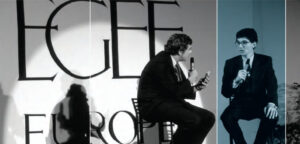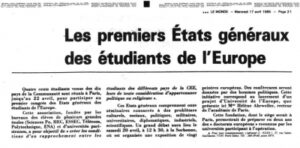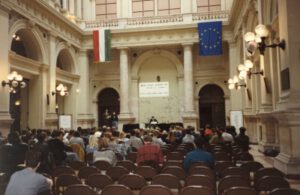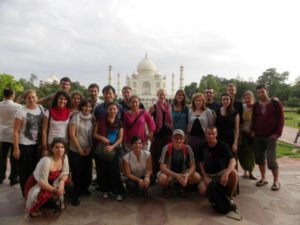History of AEGEE
1985-89: In the beginning

The 16th of April, 1985 is remembered as the day when AEGEE was born. The foundation of AEGEE was a result of the EGEE 1 conference, which was organised in cooperation with five Grands Ecoles in Paris. The whole process was led by Franck Biancheri and soon all students involved wanted to turn the EGEE conference into an organisation being the platform for young Europeans.
The aim of the founders was to create a platform for young Europeans to discuss European matters and present their ideas to both the European and national institutions. Due to the uniqueness of the idea, at that time, EGEE was able to stimulate many students to establish antennae in their cities.

The name EGEE is related to the Aegean Sea where democracy was created 2,000 years ago. Due to a name collision with a French company, the name of EGEE was changed to AEGEE in 1988.
In the 1980s AEGEE’s external relations were mainly focused on the European Communities. AEGEE promoted the placement of the Erasmus project as well as the Tempus project. This self-restrictive approach was abandoned when AEGEE opened itself to the whole continent.
1990-95: Embracing the East

In 1990, AEGEE had to face a major debate due to major changes in Eastern and Central Europe. The question of the debate was whether AEGEE should limit itself to merely the countries of the European Community (EC), or if it should open itself towards the whole of Europe. The decision of the network was in favour of expanding towards the whole of Europe and the involvement of EFTA countries. The decision taken by the East-West Working Group and the Comité Directeur – the „Quo Vadis“ team – led to an extensive growth of the network.
1996-99: Moving to Brussels and new projects

In 1996, the AEGEE headquarters moved to Brussels, giving up their temporary domicile in Delft and bringing AEGEE closer to European Institutions, where it is today.
One of the biggest projects of the time was the “Find Your Way” project in 1996, directed towards leaders of youth NGOs. “Find Your Way To and Within an Open Society” gave 800 Central and Eastern European students the opportunity to develop their democratic experience and to raise their awareness of problems in their societies.
Another memorable project of the time was the “Europe and Euro” project in 1997, raising awareness of the new European currency, five years before its introduction.
2000-05: Supporting the EU enlargement and democratisation in the East

In 2000 – 2002, new successful projects were born: Education for Democracy; Eureca, a contribution to the design of a new educational programme for the enlarging European Union. New tools were introduced – the Main Fields of Action and the Strategic Plan, which respectively define the main focus of AEGEE’s activities and the work and development of AEGEE-Europe as a whole, over a four-year period. AEGEE decided to expand its activities beyond the traditional borders of Europe, introducing the Europe in the World year plan topic, organising the Caucasus Case Study Trip in August 2003 and the World Youth Summit on Globalisation at the European Parliament in Brussels.
Significant network growth has continued into the first few years of the new millennium. Our 240 local branches organised 135 conferences and seminars and 99 Summer Universities in 2004. Two focuses in particular became obvious: AEGEE successfully offered its 15 year old experience in bridging East and West in the environment of the EU enlargement in 2004, for instance, within the framework of the Yearplan Project “EU and Europe”. The other focus regards conflict resolution in war-struck Balkan and initiatives to strengthen democracy and reconciliation in countries such as Ukraine and Cyprus. This was reflected by new projects, including “Education for Democracy”.
However, AEGEE members do not just talk about the problematic “Hotspots” – within the Yearplan project in 2005. Members of AEGEE were in the frontline during the demonstrations in Ukraine against the election fraud in December 2004. AEGEE took a firm stand for democracy as well in the summer in Albania and keeps on continuing its activities in this field. In 2005, the main focus of AEGEE was the 20th Anniversary of the Association. A series of conferences and celebrations were organised all around Europe, not to mention the biggest Gala event ever to be organised in Praha, in September 2005.
2005-Today: Crossing Borders

Crossing borders also means getting engaged in new areas for the organisation. In 2007, the Environmental Working Group was reborn and launched a major project. “Sustaining our Future” (SuFu) was selected as the Flagship Project for the period 2008-2009. It brought into the spotlight several aspects of sustainability. The project included numerous activities aiming to show the reality of sustainability in different regions of Europe, and showed different ways for young people to get involved in the topic. Among other activities, case study trips to the Danube and Scandinavia, a conference on the role of cities in sustainability in Madrid, and a Youth Think Tank in Brussels were conducted. Furthermore, the “Green Event” label was introduced, with many Summer Universities and statutory events trying to reduce their environmental impact to a minimum since then.
Active Citizenship is one of the main fields of action of AEGEE, and therefore many of the organisation’s projects have their roots in this field. The European School 2 in Oviedo (2008) marked the start of the “YOUrope needs YOU!” project that is still running today, aimed at empowering high school students and broadening their horizons. This project won the European Charlemagne Youth Prize in 2010, recognising it as an outstanding initiative to develop a shared sense of European identity. As the European Parliament elections were taking place in 2009, a series of conferences were organised around the continent as part of the “Y Vote” project, in order to encourage young people to make their voices heard at the elections.
In 2010, AEGEE took a step forward and went beyond the European borders with its flagship project, “Beyond Europe – Perspectives for Tomorrow’s World”. Among other events, the project included a Case Study Trip to India and another one to South Africa, with the aim of empowering young people in and outside Europe to tackle the global challenges they are faced with today. Another question that was raised by a project was about the borders of Europe. “Where Does Europe End?”, running between 2009 and 2012, was aimed at understanding the picture of Europe in the minds of young Europeans, and starting a discussion about the future of the EU and the continent.
Today, AEGEE has multiple ongoing projects, aimed at tackling the challenges that youth is facing today, including mobility, unemployment and conflict resolution.
